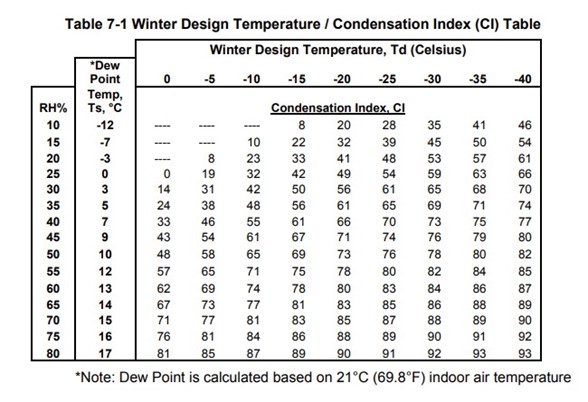The National Fenestration Rating Council and its membership developed the condensation resistance rating more than 20 years ago. While this rating was fair, accurate and credible, the rating only provided information to compare which products had the higher rating value.
The shortcoming of the NFRC condensation resistance rating was that the value could not be used to predict the likelihood of condensation forming on the product based on the following factors: relative humidity in the home, dew point temperature in the home or expected exterior air temperatures during the coldest days of the year.
NFRC and its membership fixed that. The newly approved Condensation Index (CI) allows the consumer, manufacturer, building owner or architect to find the fenestration product that best reduces the potential for condensation based on where that window, door or skylight will be in the U.S. or Canada.
In 2018, Jeff Baker shared a research study by Hakim Elmahdy with the NFRC condensation resistance task group. This paper, A Universal Approach to Laboratory Assessment of the Condensation Potential of Windows, held the key that ultimately resulted in the new NFRC CI rating.
The CI rating provides the point at which the window will potentially form condensation. This allows the end user to determine the minimum CI rating needed to reduce the likelihood of condensation forming, using Table 7-1 from the NFRC 501-2020: User Guide to the Procedure for Determining Fenestration Product Condensation Index Rating. The desired rating for a specific city or region in North America can be determined with two of the following three indicators: the winter design temperature, the relative humidity (RH%) or the dew point temperature.

Does the Industry Need Another Condensation Rating?
Our stakeholders have asked this question many times. The new CI rating will replace the existing NFRC Condensation Resistance rating and provides value and flexibility for product designs. NFRC is working closely with the CSA Group, formerly the Canadian Standards Association, to revise the CSA A440.2/.3 to add the ANSI/NFRC 500 simulation method for CI, which will align NFRC’s and CSA’s computer simulation method for a condensation index rating.
In addition, NFRC is also part of a task group at the Fenestration and Glazing Industry Alliance to potentially add a condensation index value via a physical test to the current AAMA 1503-09 test method that will also align with the ANSI/NFRC 500 tested condensation index rating.
The implementation of the NFRC CI is ready and will launch at the same time NFRC's Linear Energy Analysis for Fenestration (LEAFF) methodology is implemented. As we near the launch date, additional information will be available on the NFRC website, during NFRC’s Fall Membership Meeting and through ongoing outreach.
Condensation Resources and Research
In August 2020, NFRC held a webinar titled “Understanding the New NFRC Condensation Index” that provided details for the practical use of the rating and offered insight into how the ratings from other organizations differ from each other.
Another source of information is the Condensation Resistance Task Group page, which includes links to the original paper by Hakim Elmahdy, research documents, and other information. For more information, check out recording of the webinar and task group page at www.nfrccommunity.org.





